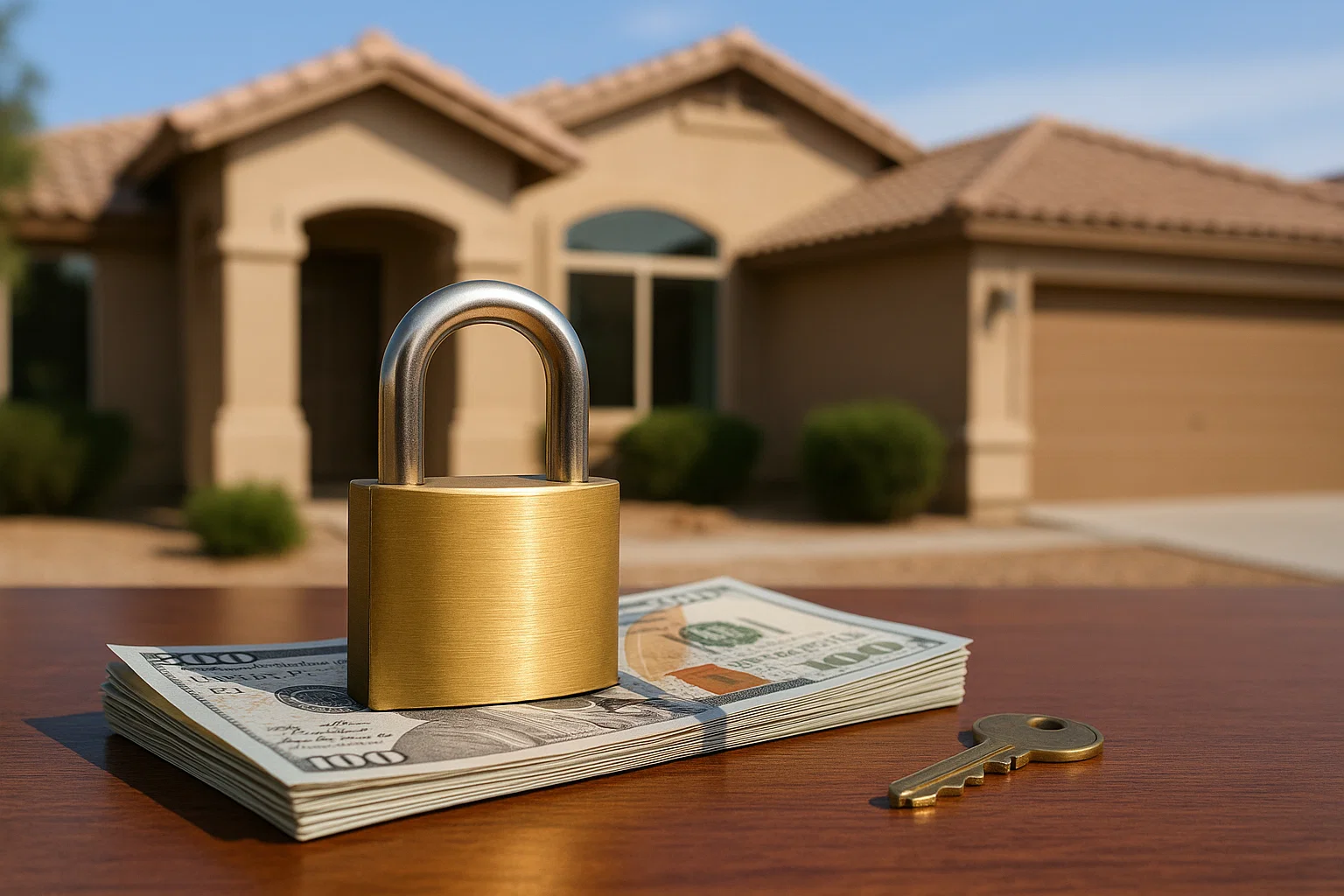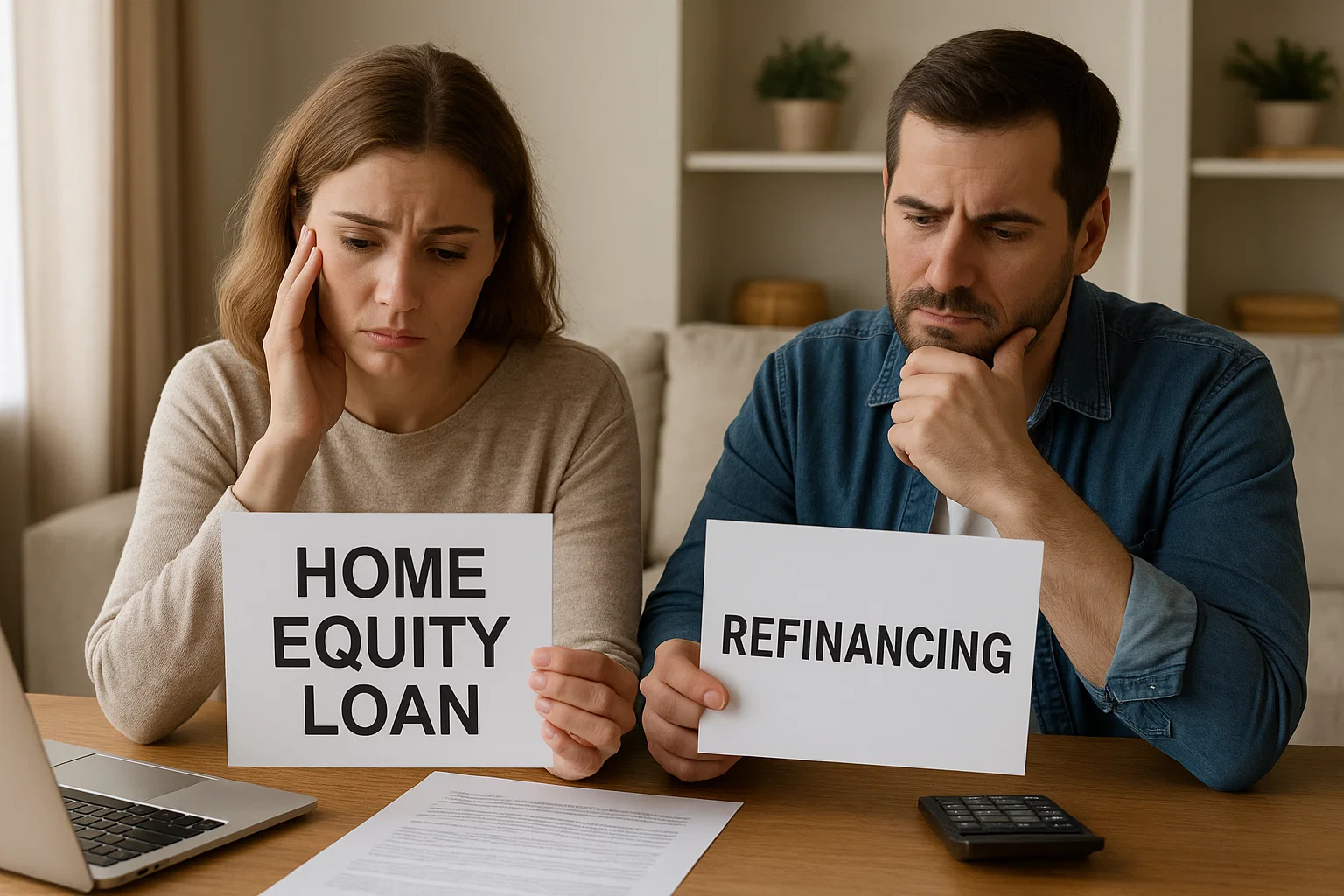Can You Refinance Your Mortgage with Bad Credit? Strategies and Options
November 19, 2025
Explore mortgage refinance bad credit options. Learn about FHA, VA, Non-QM loans & strategies to improve your chances. Refinance even with poor credit.

So, you're thinking about refinancing your mortgage but worried your credit score isn't quite up to par? It's a common concern, and honestly, it can feel like a real roadblock. Lenders often look at your credit history to decide if they'll approve you and what kind of interest rate you'll get. But here's the good news: having bad credit doesn't automatically shut the door on refinancing. There are definitely ways to go about it, and this guide is here to walk you through those options. We'll look at different loan types and some smart moves you can make to improve your chances, even when dealing with a mortgage refinance with bad credit.
Key Takeaways
- Refinancing a mortgage with bad credit is possible. Programs like FHA, VA, and USDA loans are designed to help borrowers with lower credit scores get approved.
- A mortgage broker can be really helpful in finding lenders and loan programs that work for your specific situation, especially if you have bad credit.
- Comparing offers from different lenders is super important. Even with bad credit, shopping around can help you find the best possible rates and terms.
- Improving your credit score, even just a little, can make a big difference. Focus on paying bills on time and reducing any high-interest debt you have.
- Before you refinance, check if the potential savings from a lower interest rate or payment will outweigh the costs involved. Sometimes, it's better to wait and build your credit more.
Understanding Mortgage Refinance With Bad Credit
Refinancing your mortgage when you have less-than-perfect credit might seem like a tough mountain to climb, but it's often more possible than you think. At its core, refinancing means replacing your existing home loan with a new one. This new loan could come with different terms, a different interest rate, or even a different loan amount. The main goal is usually to get a better deal, whether that means saving money each month or accessing some of the equity you've built up in your home.
What Does Refinancing With Poor Credit Entail?
When lenders look at your application to refinance, they're assessing your risk. A lower credit score signals to them that you might be a riskier borrower. This doesn't automatically shut the door, but it does mean you'll likely face some hurdles. Lenders will scrutinize your credit report more closely, and you might find that the interest rates offered are higher than what someone with excellent credit would get. It's not just about the score, though. They'll also look at your debt-to-income ratio (how much you owe compared to how much you earn) and your loan-to-value ratio (how much you owe on the mortgage compared to your home's current value).
Refinancing with bad credit often means exploring specialized loan programs or working with lenders who are more flexible. It requires a bit more homework to find the right fit, but the potential rewards can be significant.
Key Benefits of Refinancing
Even with a lower credit score, refinancing can still offer some real advantages:
- Lower Monthly Payments: If you can secure a lower interest rate or extend the loan term, your monthly mortgage payment could decrease, freeing up cash flow.
- Access to Cash: A cash-out refinance lets you borrow against your home's equity. This money can be used for home improvements, debt consolidation, or other major expenses.
- Switching Loan Types: You might be able to change from an adjustable-rate mortgage (ARM), where payments can change, to a fixed-rate mortgage, which offers payment stability.
- Eliminate Private Mortgage Insurance (PMI): If you have a conventional loan and your home's value has increased or you've paid down enough principal, you might be able to get rid of PMI, saving you money.
Potential Drawbacks to Consider
It's not all sunshine and roses, especially when your credit isn't top-notch:
- Higher Interest Rates: This is the most common drawback. Lenders compensate for the increased risk by charging a higher interest rate, which can sometimes offset the savings from a lower monthly payment.
- Limited Lender Options: Not all lenders work with borrowers who have poor credit. This can reduce your choices and bargaining power.
- Closing Costs: Refinancing involves fees, just like your original mortgage. These can include appraisal fees, title insurance, and loan origination fees. You need to make sure the potential savings outweigh these upfront costs.
Exploring Government-Backed Refinance Options

When your credit score isn't exactly stellar, traditional refinancing might feel out of reach. But don't throw in the towel just yet! The government offers several programs designed to help homeowners, even those with less-than-perfect credit, to refinance their mortgages. These options often come with more flexible requirements than conventional loans, making them a good avenue to explore.
FHA Loans for Lower Credit Scores
The Federal Housing Administration (FHA) insures loans for borrowers who might not qualify for conventional mortgages. If you have an existing FHA loan, the FHA Streamline Refinance program is a fantastic option. It's designed to make refinancing easier, often requiring less paperwork and fewer hoops to jump through. You typically won't need a new appraisal or a credit check for this type of refinance. The main goal is usually to lower your monthly payment or switch from an adjustable rate to a fixed rate. While the FHA itself doesn't set a minimum credit score, the lenders who offer these loans usually do, though they are often lower than for conventional loans. You'll need to show a history of on-time payments on your current mortgage, and the refinance must offer a tangible benefit, like a lower payment.
VA Loans for Eligible Service Members
For active-duty military personnel, veterans, and eligible surviving spouses, the Department of Veterans Affairs (VA) offers a powerful refinancing tool: the VA Streamline Refinance, also known as the Interest Rate Reduction Refinance Loan (IRRRL). This program is specifically designed to help those with existing VA loans lower their interest rate or switch to a fixed-rate loan. It's known for its minimal documentation requirements and often skips the need for an appraisal or a credit check. While the VA doesn't set a strict credit score minimum, lenders typically look for a score around 580 or higher, but they often focus more on your recent mortgage payment history. There's also a VA cash-out refinance option if you want to tap into your home's equity, but this usually involves more rigorous underwriting, including an appraisal and credit review.
USDA Loans for Rural Property Owners
If you own a home in a USDA-designated rural area and have a USDA loan, you might be eligible for a USDA Streamline Refinance. This program is aimed at helping homeowners reduce their monthly payments. Similar to the FHA and VA streamline options, it often requires less paperwork and may not need an appraisal. The focus is heavily on your payment history for your existing USDA mortgage. This makes it a viable path for those whose credit scores have dipped since they first got their loan. It's a way to get a more manageable mortgage payment without the strict credit score demands of other refinance types.
These government-backed programs are lifelines for many homeowners struggling with credit issues. They recognize that a person's financial situation can change, and they provide pathways to more affordable housing costs through refinancing, even when credit scores aren't perfect. It's worth investigating if you fall into one of these categories.
Leveraging Specialized Loan Programs

Sometimes, the standard mortgage options just don't fit, especially if your credit isn't in the best shape. That's where specialized loan programs come in. These programs are designed to help people who might not qualify for conventional loans, offering more flexibility.
Non-Qualified Mortgages (Non-QM) Explained
Non-QM loans, or non-qualified mortgages, are a bit different from the usual loans. They don't have to follow all the strict rules set by the Consumer Financial Protection Bureau. This means lenders can be more flexible with things like credit scores and income verification. This flexibility can be a real lifesaver if you have a lower credit score or a less traditional income stream. However, because they're more flexible, these loans often come with higher interest rates compared to standard mortgages. Think of it as paying a bit more for a loan that's more accessible.
Fannie Mae and Freddie Mac Programs
Fannie Mae and Freddie Mac are big players in the mortgage market, and they have programs that can help homeowners with weaker credit. Programs like Fannie Mae's RefiNow and Freddie Mac's Refi Possible are designed for people who might not meet typical credit score requirements. They often accept higher debt-to-income ratios, which is good news if you have a lot of existing debt. To qualify for these, your current mortgage usually needs to have been originated at least a year ago.
Freddie Mac's Refi Possible Program
Freddie Mac's Refi Possible program is specifically aimed at helping homeowners refinance, even if their credit isn't perfect. It doesn't have a minimum credit score requirement, which is a big deal. Plus, it allows for debt-to-income ratios up to 65%. This program can be a great way to lower your monthly payments or switch to a fixed rate. It's important to remember that your existing mortgage must have been taken out at least 12 months prior to applying. If you're looking for a way to improve your mortgage terms and don't quite fit the traditional mold, this is definitely worth looking into. You can find more information about mortgage options through Sunlite Mortgage if you're facing credit challenges.
Strategies for Improving Your Chances
Okay, so you've got less-than-stellar credit and you're looking to refinance your mortgage. It can feel like a tough road, but don't throw in the towel just yet. There are definitely ways to boost your application and get approved for a better deal. It's all about being smart and prepared.
Working With A Mortgage Broker
Think of a mortgage broker as your personal guide through the confusing world of home loans. They aren't tied to just one bank, so they can shop around for you. This is super helpful when you have bad credit because they know which lenders are more likely to work with you and which loan programs might be a good fit. They can also help you understand all the paperwork and requirements, which is a big relief.
Comparing Multiple Lenders
Don't just go with the first lender you talk to. Seriously, shop around! Different lenders have different rules, especially when it comes to credit scores. Some might be more flexible than others, or they might offer slightly better terms. It takes a bit more effort, but comparing offers from at least three to five different lenders could save you a lot of money over the life of your loan. You can check out banks, credit unions, and online lenders.
Understanding Credit Score Requirements
Every loan program has its own idea of what a 'good' credit score is. Government-backed loans like FHA, VA, and USDA often have lower minimums, which is great news for people with bad credit. Conventional loans usually want higher scores. Knowing these minimums helps you figure out which options are even on the table for you. It's also good to know that lenders look at more than just your score; they'll check your debt-to-income ratio and how much equity you have in your home too.
Even small improvements in your credit score can make a noticeable difference when you're applying for a refinance. Paying down existing debts, especially those with high interest rates, can positively impact your credit utilization ratio and show lenders you're managing your finances responsibly. Making all your payments on time, every time, is also a huge factor in building a stronger credit profile.
Here's a quick look at how different factors play a role:
- Credit Score: This is the big one. Lenders use it to gauge your risk. Lower scores mean higher interest rates or potential denial.
- Debt-to-Income Ratio (DTI): This compares how much you owe each month to how much you earn. A lower DTI is generally better.
- Loan-to-Value Ratio (LTV): This is the amount of your mortgage compared to the value of your home. More equity (lower LTV) can make lenders more comfortable.
- Payment History: Consistently paying your bills on time is a strong indicator of reliability.
Steps to Improve Your Credit Score
So, your credit score isn't exactly stellar, and you're wondering about refinancing your mortgage. It's a common situation, and the good news is that you can often take steps to boost that score before or even during the refinance process. Think of it like prepping for a big job interview – you want to look your best, and a higher credit score makes you a more attractive borrower.
Monitor Your Credit Report Diligently
First things first, you need to know what's actually on your credit report. You're entitled to a free report from each of the three major credit bureaus (Equifax, Experian, and TransUnion) every year. You can get these at AnnualCreditReport.com. When you get them, don't just glance at them. Really look through them. Are there accounts you don't recognize? Are there late payments listed that you know you made on time? Errors happen, and they can drag your score down. If you spot something wrong, dispute it with the credit bureau. It might take a little effort, but correcting mistakes can make a noticeable difference.
Prioritize On-Time Payments
This is probably the biggest factor influencing your credit score. Lenders want to see that you pay your bills when they're due. Seriously, it's that simple. Even one or two late payments, especially if they're more than 30 days past due, can really hurt your score. If you struggle to remember due dates, set up automatic payments for your mortgage, car loan, credit cards, and any other bills. Many banks and lenders offer auto-pay options, which can be a lifesaver. Consistency here is key.
Reduce High-Interest Debt
Got a bunch of credit card balances hanging around? Those high interest rates can really add up, and they also impact your credit utilization ratio. Paying down these balances, especially on cards with high interest, can free up your cash flow and improve your credit score. It shows lenders you're managing your debt responsibly. Focus on tackling the debts with the highest interest rates first, as this will save you the most money in the long run.
Manage Credit Utilization Wisely
This refers to how much of your available credit you're actually using. Experts generally recommend keeping this ratio below 30%. So, if you have a credit card with a $10,000 limit, try to keep your balance below $3,000. Using too much of your available credit can signal to lenders that you might be overextended. Paying down balances, as mentioned before, directly helps with this. It's not just about making payments; it's about how much credit you're using relative to what you have available.
Building a better credit score takes time and consistent effort. It's not usually an overnight fix. Focus on the fundamentals: pay bills on time, keep balances low, and check your reports for errors. These actions not only help with refinancing but also set you up for better financial health overall.
Here's a quick look at how these actions can help:
- On-Time Payments: The single most impactful factor for your credit score.
- Credit Utilization: Aim to keep balances below 30% of your credit limit.
- Error Correction: Removing inaccuracies can directly boost your score.
- Debt Reduction: Lowers your overall debt burden and improves utilization.
Making the Right Refinance Decision
So, you've looked into refinancing with less-than-perfect credit and explored some options. That's great! But before you jump headfirst into a new mortgage, it's super important to pause and really think about whether it's the right move for you right now. It’s not just about getting approved; it’s about making sure the new loan actually helps your financial situation in the long run.
Assessing Current Interest Rates
Interest rates are a big deal when you refinance. They're like the engine of your mortgage – they determine how much you pay over time. Even a small difference in the interest rate can add up to thousands of dollars over the life of your loan. It’s worth checking out what the current market rates are. You can find this information online or by talking to lenders. Remember, rates can change daily, so keep an eye on them. If rates are high, refinancing might not save you much, or could even cost you more.
Calculating Potential Savings
This is where you get to see the real impact of refinancing. You need to figure out how much money you'll actually save. This involves looking at your current mortgage payment and comparing it to what your new payment would be. Don't forget to factor in all the costs associated with refinancing, like appraisal fees, closing costs, and any prepayment penalties on your old mortgage. Sometimes, a lower monthly payment isn't the whole story if the total cost over the loan's life is higher. A simple way to do this is to create a little spreadsheet. List your current loan details, the proposed new loan details, and all the associated fees. Then, calculate the total cost for both scenarios over, say, five or ten years. This will give you a clearer picture.
Here’s a basic way to think about it:
- Current Mortgage: Monthly Payment x Remaining Months = Total Remaining Cost
- New Mortgage: (New Monthly Payment x New Loan Term) + Refinance Costs = Total New Cost
- Savings: Total Remaining Cost - Total New Cost
It's easy to get caught up in the idea of a lower monthly payment, but you have to look at the big picture. Are you paying more interest over the entire loan term? Are the closing costs so high that they eat up all the savings from a lower rate? These are the kinds of questions you need to ask yourself before signing on the dotted line.
When to Wait and Build Credit
Sometimes, the best decision isn't to refinance right now. If your credit score is really low, you might be getting offered interest rates that aren't much better than what you have now, or maybe even worse. In these cases, it might be smarter to hold off. Use the time to work on improving your credit score. Focus on making all your payments on time, reducing any outstanding debt, and checking your credit reports for errors. Building a stronger credit history can open doors to much better refinance deals down the road. It might feel like a setback, but a little patience now could save you a lot of money and stress later. You can find resources to help you understand your home equity and see how much you might be able to borrow, which is a good first step before deciding to refinance or wait.
Wrapping It Up
So, can you actually refinance your mortgage when your credit isn't top-notch? The short answer is yes, it's definitely possible, though it might take a bit more digging. We've seen that government-backed loans like FHA and VA are often more forgiving on credit scores. Plus, working with a mortgage broker can really open doors to lenders who understand these situations. Remember, improving your credit score, even a little, can make a big difference in the long run. Don't get discouraged if your first try doesn't work out. Keep making those payments on time, keep an eye on your credit report, and explore all the avenues we've talked about. You might just find a way to get a better deal on your mortgage, even with less-than-perfect credit.
Frequently Asked Questions
Can I really refinance my mortgage if my credit isn't great?
Yes, you can! It might be a bit trickier, and the interest rates could be higher, but there are special loan programs and lenders who work with people who have lower credit scores. Think of FHA or VA loans – they're designed to help out.
What's the lowest credit score needed to refinance?
It really depends on the type of loan. For regular loans, lenders often want a score of 620 or more. But for loans like FHA, you might get approved with a score as low as 580, and sometimes even 500 if you can put more money down.
What are the main benefits of refinancing, even with bad credit?
Even with less-than-perfect credit, refinancing can help lower your monthly payments, potentially save you money on interest over time, or let you switch from a loan with changing rates to one with a steady rate. You might also be able to get some cash out from your home's value.
What are the downsides to refinancing with bad credit?
The biggest downsides are that you'll likely get higher interest rates, and you might have fewer loan choices. Also, there are closing costs involved, like fees for appraisals and paperwork, which could add up and might even be more than you save.
How can a mortgage broker help me refinance with bad credit?
A mortgage broker is like a guide who knows the lending world. They can connect you with lenders who are more likely to work with borrowers who have lower credit scores. They can also help you compare different offers to find the best one for you.
What are some simple steps I can take to improve my credit score before refinancing?
Start by checking your credit report for mistakes and fixing them. Always pay your bills on time – this is super important! Try to pay down debt on your credit cards, especially the ones with high interest. Also, try not to use up too much of your available credit limit.













Get in touch with a loan officer
Our dedicated loan officers are here to guide you through every step of the home buying process, ensuring you find the perfect mortgage solution tailored to your needs.
Options
Exercising Options
Selling
Quarterly estimates
Loans
New home

Stay always updated on insightful articles and guides.
Every Monday, you'll get an article or a guide that will help you be more present, focused and productive in your work and personal life.









.png)
.png)
.png)
.png)
.png)
.png)
.png)
.png)
.png)
.png)
.png)
.png)
.png)
.png)
.png)
.png)
.png)
.png)